Foreground detail of residential area at Salt Lake City, Utah Territory settlement in line with a more broader sweeping view of same area found in the image detail above more clearly showing the same road details and small residential or random commercial structures.
Detail: Outskirts of Salt Lake City settlement, Utah Territory. Smoke in distance may indicate that this area of the settlement, as it lies against the towering Oquirrh Mountain Range is possibly engaged in industrial or manufacturing activity.
A magnificent snowcapped tier of rolling peaks beckons the eye to see through the hazy sky at the north western tip of the Oquirrh Mountain Range. It is the great mountain which stretches behind both the Provo Valley and Salt Lake Valley in Utah Territory. Here past the low rolling hills seen at the distant edge of the great plains leading out of Salt Lake Valley, Utah Territory, the scattered Mormon settlement at Salt Lake City lies roughly 40 miles south of the areas of Weber Canyon ,and Ogden, Utah Territory. Salt Lake City is home of the "Twelvites" (cum Brighamites) and Brigham Young. It is the latter who is the President of The Church of the Jesus Christ of Latter-Day Saints and Territorial Governor. This is where Mormon head Young lives with other Mormon followers and all of their many wives. It is here in the Salt Lake Valley where the Mormon church flourishes and where its people live and toil. It is through the distant passage at the painting's center point where one would leave the Mormon kingdom of God's Salt Lake City, the new marvel of the American West. It lies here in the northern tier of a 19th century Utah Territory parallel to the Wasatch Mountains on the opposite side of the Salt Lake Valley, facing the east. Separate from the Springville and Provo settlements and as much as sixty miles north and above these parts is where Salt Lake City begins, beside the great Salt Lake itself; the popularly celebrated bathing retreat for the new Utahans.
Larger detail of small scattered residential or commercial structures at Salt Lake City.
Another detail showing sampling of oil painting brush strokes and artist technique.

Bottom right verso corner of partial section of outer gold gilt frame and painting stretcher assembly.
Albert Bierstadt (1830-1902), Salt Lake City, Wasatch Mountains, Uintah Range, c. 1881, oil on paper on board, 13 1/2 x 19 1/2 inches. Brigham Young University Museum of Art, gift of Lee A. Carson, 1982.
(Courtesy: Private Collection)
Detail of Salt Lake City outskirts at foot of Oquirrh Mountains, Utah Territory - seen in circa 1860's unsigned oil on canvas and matched with Bierstadt's c. 1881 Near Salt Lake City oil painting detail shown above 1860's unsigned Salt Lake City oil on canvas.
Full view of oil painting of Salt Lake City, Salt Lake Valley, Oquirrh Mountains - comprising Salt Lake City settlement activity, Utah Territory, circa 1860's. (Courtesy: Private Collection)
Detail of oil painting brush strokes and artist technique.


A great widespread breadth of Utah Territory lay before the eye. A sole majestic American eagle can be seen spreading it wings as it soars through the skies. Like candy for the mind. He who seeks and soaks in the great visage before him allows the spirit of his conviction into his heart and into his soul. Certainly a great view to the eye of the beholder that lays before him as the Oquirrh Mountain range towering above Salt Lake Valley glistens under the Mormon spirited sun. Far now in the distance the mind soaks in the sight looking into the Salt Lake Valley, where Salt Lake City bustles 45 miles north of Provo. The hazy rolling folds of the northern peaks of Oquirrh Mountain range can be seen clearly, even from this great distance; displaying ever proudly their grand sparkling shiny snowcapped tips. (Courtesy: Private Collection)



(Courtesy: Private Collection)
OIL ON CANVAS OVER WOOD STRETCHER
MEASUREMENTS: 34 1/8” x 54 1/8” (87.125 cm x 137.125 cm)
HOUSED IN VINTAGE GOLD GILT OVER GESSO FRAME
Verso of gold gilt over gesso frame, wood canvas stretcher and re-lined canvas backing.
Verso Details Showing
Stretcher and Frame
DISCUSSION ON OIL PAINTING OF SALT LAKE CITY, UTAH TERRITORY -
AT FOOT OF OQUIRRH MOUNTAINS

Bottom left verso corner showing partial section of outer gold gilt frame and painting stretcher assembly.
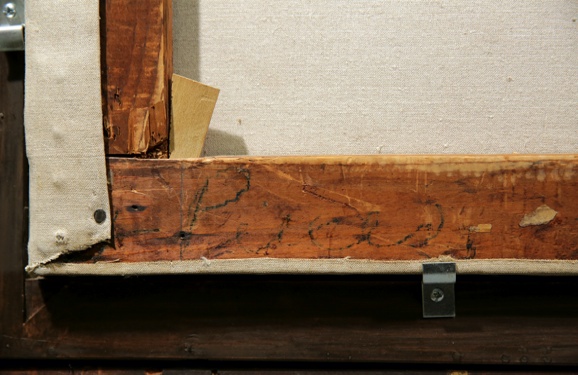
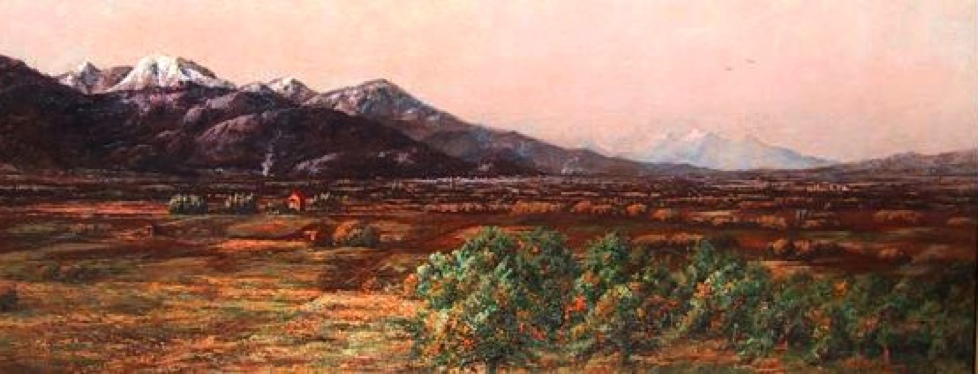

Certainly, examining this striking, recently discovered previously unrecorded oil on canvas depicting a very long stretch of what is clearly the Oquirrh Mountains in Utah, will raise some questions wanting to be addressed. The work is unsigned as to the artist. This painting is unique in many ways. The 19th century oil painting depicts early Mormon settlement life in the Utah Territory after 1860 and is classified as being work executed within principal technique founded under a branch of painting known as the "American School," and more finitely known as "The American School of landscape painting." The work measures quite large at approximately 34" x 54" in size.
The massive oil depicts a scene looking west towards California Territory of what is apparently the Salt Lake Valley and the early settlement at Salt Lake City, Utah Territory with the great Oquirrh Mountain range behind. To the left would be the southwestern section of Salt Lake City, Utah Territory. This painting is significant in that no other period oil painting known is as large as this one that shows the Salt Lake Valley and vast expanse of pioneering Mormon settlement activity.
As well, this painting appears to be the earliest painting of Salt Lake City, and seems to pre-date the two Albert Bierstadt paintings dating to 1881 that are held in the collection of the Brigham Young University Museum of Art, Provo, Utah. Each of these Bierstadt paintings measure approximately only 14" x 19" in size.
It is most interesting to note that Bierstadt's two Utah paintings were executed in the same year of 1881 that the Utah Art Association was formed.
What is particularly significant about the large unsigned oil is that the Oquirrh Mountains it depicts shows a strikingly similar viewpoint to that seen in the much smaller 1881 oil by the premier American artist Albert Bierstadt entitled; Near Salt Lake City Utah - shown below.
This Bierstadt measures a diminutive 13 7/8" x 18 7/8" (35 .2 x 47.9 cm), as opposed to the larger unsigned work primary to this discussion which, as stated prior, is approximately 34" x 54" in size. What is wholly outstanding is that this large approximately 34" x 54" unsigned oil on canvas primary to this discussion is basically a whopping nine times larger than the 1881 Bierstadt oil Salt Lake City Wasatch Mountains, Uintah Range or his Near Salt Lake City Utah work of approximately the same size!
The first consideration asserting that the larger unsigned work is assuredly that of Salt Lake City is based on the mountain range trajectory behind the 'settlement' found in both the larger unsigned work, and the smaller Bierstadt Near Salt Lake City Utah work from 1881.
Since the smaller Bierstadt work is definitely known to be Salt Lake City against the Oquirrh Mountains, the Bierstadt painting takes on much more meaning because the large approximately 34" x 54" unsigned work appears to have been painted from the same general area, although, Bierstadt's Near Salt Lake City Utah shows the same basic visage, but from a little bit further back near Arsenal Hill - now Capitol Hill.
Significantly, both of Bierstadt's 1881 paintings were painted from the same general vicinity atop Arsenal Hill. As well, Albert Bierstadt's Near Salt Lake City Utah shows a wider expanse of the Oquirrh Mountains and more contours - much more than the large 34" x 54" unsigned oil on canvas of Salt Lake City primary to this discussion.
Also to be considered, both paintings are from nearly the same angle - allowing one to most easily conduct a most definitive comparative analysis between the small Bierstadt and the larger unsigned oil on canvas to conclude that this larger unsigned work of primary discussion herein is in fact of Salt Lake City, Utah Territory looking west toward California Territory - all facing the Oquirrh Mountains to the west.
There are two prominent books on the history of paintings and art of Utah, but to a great dismay, virtually no references are made to or show paintings of Mormon settlement activity with the Oquirrh Mountains behind!
One book is entitled: Paintings of the Wasatch Mountians by Robert S. Olpin, Ann W. Orton and Thomas F. Rugh - released by Gibbs Smith, Publisher, Salt Lake City, Utah, 2005. This large coffee table sized book is lavishly illustrated in color with key works found in the great United States based institutional art collections, but nothing, understandably evident by the book's title, come up referencing Oquirrh Mountains in the book's index.
A second, slightly earlier companion work under the same Gibbs Smith, Publisher imprint is the 1997 published work entitled: Utah Painting and Sculpture by Vern D. Swanson, Robert S. Olpin and William C. Seifrit. Although also including sculpture, this illustrated work as well fails to show any paintings with the Oquirrh Mountains as a backdrop.
Most amazing is that the sole little Bierstadt Near Salt Lake City Utah - with the Oquirrh Mountains behind, remarkably acts as the most definitive benchmark in identifying the unsigned and unmarked larger painting primary to this discussion. All in the same instance this Bierstadt provides assertive insight into most conclusively identifying the larger approximately 34" x 54" unsigned work clearly and most apparently to be that of Oquirrh Mountains, which in turn asserts the Salt Lake City identification as most conclusive.
In dating the Bierstadt Near Salt Lake City Utah, a companion oil that Albert Bierstadt executed on the same sized paper that he was utilizing on his second trip out west in 1881 - in Bierstadt's Salt Lake City Wasatch Mountains, Uintah Range - shows a large storied tower as part of a building, a structure which Brigham Young University scholars believe is that of the "J. R. Walker house" - which they have asserted in a in-house databased assessment as having been known to having been constructed in 1867 in downtown Salt Lake City.
These recent BYU Museum studies have therefore concluded that since the J. R. Walker house did not exist in 1863, the year when Bierstadt made his first trip to Utah and Salt Lake City, Bierstadt's Salt Lake City Wasatch Mountains, Uintah Range - which was never dated by Bierstadt - had to have been painted during Bierstadt's 1881 return trip to Salt Lake City. It should be noted that the BYU studies that had referenced the J. R. Walker house in their report, show the “house” portion of the designation fully in lower caps, which on its face, reasonably denotes a private residence. For fellow Mormon history scholars and students alike, this notion of the J. R. Walker house is presented in a skewed fashion.
Not withstanding, this offset reference to a private residential structure, when actually viewed in context to the tall structure depicted to the center right in the 1881 Bierstadt painting, becomes also more non-assertive because the tall structure Bierstadt depicted, seems to stand not four but actually five stories tall or more. It appears to be more in the form of a watchtower at a fort than that of a commercial hotel comprising 132 rooms, which we now know and can now see, was no more than four stories tall. Please see accompanying photo.
The tall pyramid capped tower showing in the painting is either next to or attached to the long building seen closer to the viewer of the 1881 Bierstadt painting. This long building that Bierstadt shows looking much like the front of the "Walker House" that is shown in C. W. Carter's c. 1868 stereoview of same shown herein, but seeing it from the side. If this building that Bierstadt shows is in fact the very "Walker House" hotel depicted in the C. W. Carter c. 1868 stereoview, then the tower is twice the size of a four story building.
Yet, when one looks at the left side of the c. 1868 "Walker House" shown in the C. W. Carter stereograph, one can clearly see only a small two story clapboard styled residence beside it - but not a tall tower structure of any kind. If the tower shown in the 1881 Bierstadt ever actually existed in reality, it obviously should easily be seen to the left side in the 1868 C. W. Carter stereograph hereof provided, or even to the right side: But it is not.
So, can it now be said that Albert Bierstadt exercised his option of using 'artistic licence' to include the tall tower only as a means, perhaps to balance out the compostion he was painting? If not this, then what?
Thus, with no definite benchmark to explain the presence of the tall tower structure in Bierstadt's Salt Lake City Wasatch Mountains, Uintah Range, the only basis to support the notion as to when the painting was actually executed by Bierstadt rests solely on the comparison of the paper size Bierstadt used in making both Salt Lake City Wasatch Mountains, Uintah Range and also Near Salt Lake City Utah - which are both basically the same size. A juxtaposed comparison made between these two works with that of the other same size works Bierstadt further executed on paper during his 1881 painting excursion out west, irrefutably further supports the "1881" date assertion for the two works as conclusive.
Bierstadt's known use of a different standardized size of paper during his 1863 western sorjorn clearly negates any notion that Salt Lake City Wasatch Mountains, Uintah Range and also his Near Salt Lake City Utah - could have been painted at anytime other than in 1881.
Moreover, this all now sheds yet a different light on Bierstadt’s work; at least on that conducted in the Salt Lake Valley and Salt Lake City area. What does this more precisely all equate to here? As can plainly be seen here more clearly on this page showing the two Bierstadt paintings in juxtapose to the two photograph images shown taken in 1867-1868 by C. W. Carter, it is clear as day that Salt Lake City was in fact tremendously flourishing city just after the Civil War and even had horse drawn trolleys like the big cities further east.
However, when one looks at Bierstadt’s 1881 paintings shown herein, the scene portrayed is not at all accurate as to a cityscape’s real growth that would have honestly been in place by 1881. There are few city streets depicted in Bierstadt’s Salt Lake City Wasatch Mountains, Uintah Range. Although the distant areas depicted in the painting do show some square looking 'buildings' with some lights - all in a line - thus denoting buildings being situated along streets - the painting lacks the population density that should have been in place by 1881.
All in all, can it be said that the two Salt Lake City area paintings by Albert Bierstadt were actually executed in a more lyrical or fantastical depiction of a Salt Lake City environs? Perhaps more scholarly study will be required in this regard as to how to better interpret some works by Albert Bierstadt over that of others?
In the course of his on going work, while preparing this page for publication hereof, Mormon studies author Richard Warren Lipack acquired an original photographic image in stereoscopic form by the great Mormon photographer C. W. Carter that the artist took of the “Walker House” in down downtown Salt Lake City, which, on the lower right side of the twin view’s printed light green mount, it reads: “Size, 82 1/2 x 114 1/2 feet - Height 65 feet - Containing 132 rooms.”


With this interesting find in historical 19th century photography, the evidence brought forth that the “Walker House” was a 132 room hotel, and likely considered the tallest building in Salt Lake City when the image was taken around 1867-1868, easily corresponds to the data that the BYU Museum studies has confirmed that the "J. R. Walker house" was constructed in 1867 in downtown Salt Lake City.
The round corner green card stereoview mount was introduced in 1868 and was shortlived, supplanted in 1872 with a round corner orange card mount. Square cornered orange mounts, and even dark purple mounts with often descriptive paper labels on their versos sporadically were used for a few years after the Civil War. The round corner canary yellow stereoview card mount was introduced in 1866 and was used into 1868. Prior to this was the square corner canary yellow stereoview card mount that dates to between 1861 and 1865 that had affixed to it descriptive labels. Actually, the paper label had been the card form's original innovation as it allowed for a more versatile ability to mark and identify the card on its verso by affixing pre-printed descriptive labels on a need basis onto a standardized production card stock.
Dating early stereoviews is primarily based on the color of the mounts and this system of dating stereoviews using this basic tenet was first progmulgated and documented by the late expert collector and stereoview historian William Culp Darrah and this method of stereoview dating is profusely covered in his 1962 book: Stereo Views - A History of Stereographs in America and Their Collection, published by the Times and News Publishing Co., Gettysburg, Pennsylvania.
Thus, this evidence herein coming forth showing a newly built "Walker House" in a stereograph mounted on a 1868 period round corner light green colored mount by Mormon photographer C. W. Carter, provides and reveals confirmation of the 1867 year date affirmatively and also is the date that the BYU Museum maintains in its studies file.
However it seems that there are two small facts that remain to be established, the first being - if in fact the four story tall "Walker House" commercial hotel structure we now know existed, as documented by photographer C. W. Carter happened to be the same "J. R. Walker house" BYU has thus so far referenced? Secondly, if records still exist, can it be safely presumed that a man by the name of "J. R. Walker" had built, owned and operated the "Walker House" in downtown Salt Lake City, Utah Territory when C. W. Carter recorded the building's 3-dimensional likeness on photographic paper in 1868?
Now it should always be remembered that Albert Bierstadt's Near Salt Lake City and also his Salt Lake City Wasatch Mountains, Uintah Range are both on the same sized paper measuring approximately 14" x 19" (and both later laid on to canvas), and that the Salt Lake City Wasatch Mountains, Uintah Range work has been properly identified as having been executed in 1881, and matches the size of other preliminary works Bierstadt executed in 1881 during his trip to other western regions beyond Utah. The work: Near Salt Lake City, Utah, as well, conclusively dates to 1881 because it matches-up with Albert Bierstadt's other works from his 1881 excursion out west.
During the artist’s excursions out west, Bierstadt came to develop a painting ‘system’ whereby he would make small paintings usually in the oil medium first on paper during these trips he conducted. These works he produced could easily be rolled up or stored, and when Bierstadt returned back east, he would take the smaller preliminary executed artwork and use it to create his much larger and more celebrated works he became famous for.
Another significant factor found in the Bierstadt Near Salt Lake City Utah work can be found in the foreground detail of the painting shown above. The details show what appears to be newly constructed two story homes. The homes are more conventional in style to that of the 1880's and not so much like that of the earlier form found in homes and buildings built during the 'settler period' of the 1860's and before - which were predominately smaller in size and of simplistic designs - with minimal construction technique. They were generally of the 'clapboard' type form - such as the 'clapboard' style structures shown below taken from a 1868 green card stereograph by C. W. Carter of Zion's Co-Operative Mercantile Institution. It is interesting to note that Zion's Co-Operative Mercantile Institution became established by different business owners in separate store fronts during the Institution's initial founding by Brigham Young.
Buildings of this so-called 'clapboard' form were supplanted with more modern building designs and techniques by the 1880's, as can clearly be seen evidenced in the third photograph shown below by C. W. Carter on a early to mid-1880's boudior mount orange stereo card by the much larger building that became the new 1880's Zion's Co-Operative Mercantile Institution, replacing the original small by comparison 1860's Zion's Co-Operative Mercantile Institution.
The residential homes depicted in the foreground of Alfred Bierstadt's Near Salt Lake City Utah are clearly of a later form of construction and certainly not from the time period of the 1860's. This factor alone acts as another means which asserts that Near Salt Lake City Utah was painted by Bierstadt in 1881.



Albert Bierstadt (1830-1902), Near Salt Lake City Utah, c. 1881, oil on paper on board, 13 7/8 x 18 7/8 inches. Brigham Young University Museum of Art, 1965.
Albert Bierstadt (1830-1902), Near Salt Lake City Utah, c. 1881, oil on paper on board, 13 7/8 x 18 7/8 inches. Brigham Young University Museum of Art, 1965. (Attribution credit for above and below.)
(The above image constitutes the artist's full dimensional work and the image below shows a cropped detail of the Oquirrh Mountain Range found in same work as above - Near Salt Lake City Utah.)

Albert Bierstadt (1830-1902), Salt Lake City, Wasatch Mountains, Uintah Range, c. 1881, oil on paper on board, 13 1/2 x 19 1/2 inches. Brigham Young University Museum of Art, gift of Lee A. Carson, 1982.
The above constitutes a detail of 1881 Alfred Bierstadt painting entitled Salt Lake City, Wasatch Mountains, Uintah Range, showing multi-story structure believed to be "J. R. Walker house" built in 1867.
Thus, judging from the scant visible structures shown in the approximately 34" x 54" unsigned larger work of Salt Lake City executed as an oil on canvas by a unknown artist, this larger work appears to have been executed sometime before Bierstadt's return to the Salt Lake Valley region in 1881. How much earlier can one say that this work was executed? Further study is required but the work appears to date to the early 1860's, especially in juxtaposition to the vast expanses of population clearly evident in the 1870 and 1875 dated maps in the United States Library of Congress collection in Washington, D.C. reproduced below.
How important a painting is this newly found large unsigned work executed on canvas of Salt Lake City? Will it perhaps depend on what else Mormon scholars seek to garner from follow-up research they may choose to conduct towards further comparative analysis with other data or images that exist or may be found in the future?
The right side half of a stereo pair depicted above by the prolific Salt Lake City photographer C. W. Carter shows the 'second phase' of Zion's Co-Operative Mercantile Institution shortly after its re-construction in the early 1880's on the site of the original commercial exchange that began in the mid-1860's, as that which is depicted in the earlier image with the oxen - preceding this one in discussion. At the time it was erected, it quickly gained notoriety of being the very first ever department store built in America. In fact, for many years it used the slogan, "America's First Department Store."
Please note the telegraph pole that carried the telegraph to downtown Salt Lake City on the image above. The advent of electric telegraph communications and the sending of Morse Code messages became a reality following the "Joining of the Rails" on May 10, 1869 at Promotory Point, Utah.
The westward expansion of the railroad from the eastern states and the mid-west brought with it the laying of telegraph lines. By the 1880's the American telegraph was networked all across the United States of America and telegraph offices had fast become an integral part of American 19th century life - where anybody could afford to send and receive messages across the continent instead of using the Pony Express.
Note the words: "Zion's Co-Operative Mercantile Institution" - seen in the bottom rung of this newly constructed building's face just above the first floor awnings, now in broad big block letters. Below is shown an interior view taken in the same building, with much activity vividly portrayed in premier photographer C. R. Savage's C.D.V. image.
The doors of Zion's Co-Operative Mercantile Institution opened at the end of 1868. The enterprise had been founded by a now former Mormon Territorial Governor Brigham Young on the 9th of October that year. The above albumen photographic image by C. W. Carter shows, in a somewhat romantic fashion - how simple Mormon life really was when it began to flourish in the Utah Territory. Main street downtown Salt Lake City still had dirt surface roads. Oxen, as can be seen here, would lazily lay comfortably in the dirt road (or mud when it rained), when not pulling a wagon loaded with goods procured from Zion's Co-Operative Mercantile Institution. The businesses that made up Zion's Co-Operative Mercantile Institution were clearly Mormon merchants with an affinity to Mormanism and the Lord, as their signage proudly proclaimed and was apparently prompted by Brigham Young's insistance, as he was the owner of the exchange. All three business members of Zion's Co-Operative Mercantile Institution business concern displayed signage that included the grand religious proclaimation:
"HOLINESS TO THE LORD."
Look closely now at this panorama view shown above of Salt Lake City, Utah Territory in the Salt Lake Valley. Look closer now at the grand sweeping Oquirrh Mountain range towering west behind in the distance. Now look closely at the specific contour of the more prominent peaks of the tip of the Oquirrh Mountains that are seen directly above the highly visible red two story residence - the one which shows one quarter of the way across from the left side of the painting.
The same Oquirrh Mountain peaks found in Albert Bierstadt's c. 1881 Near Salt Lake City are found here.
The bourgeoning populous shown and depicted is that of Salt Lake City, the christened capital for Utah Territory's growing part in the American Western expansion.
It is not far from here is where the "Golden Spike" would be driven into the ground at Promontory Summit, Utah Territory. With United States President Ulysees S. Grant in attendance, the "Joining of the Rails" commenced there on 10 May 1869 - completing the First Transcontinental Railroad - in the United States of America.
****************************
(Courtesy: Private Collection)
FRONTAL VIEW OF UNSIGNED UTAH TERRITORY OIL ON CANVAS


SCROLL DOWN AUTHENTICATION OF UNSIGNED UTAH TERRITORY OIL ON CANVAS
Mormon Settlement in Utah Territory
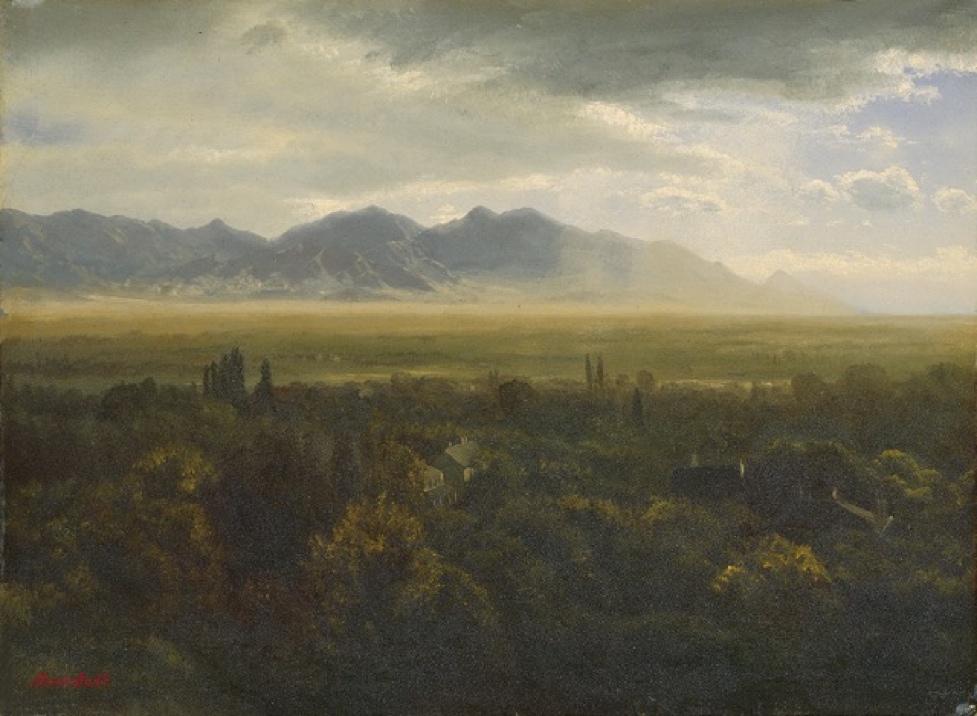

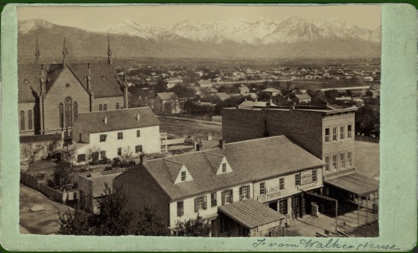


Albert Bierstadt (1830-1902), Near Salt Lake City Utah, c. 1881, oil on paper on board, 13 7/8 x 18 7/8 inches. Brigham Young University Museum of Art, 1965.
The above image constitutes artist Albert Bierstadt's circa 1881 full dimensional work of the Oquirrh Mountain Range entitled: Near Salt Lake City, which, if one looks closely and compares the predominate features of the mountain range between Bierstadt's circa 1881 Near Salt Lake City and the mountain range in the circa early to mid 1880's C. D. V. (Carte des Visite) albumen photograph below by Salt Lake City photographer C. W. Carter entitled and penciled in period hand "From Walker House," (the 4 story hotel built in 1867), one can see the similarities between the two mountain ranges depicted.
In fact, the Bierstadt shows just a little more to both the left and to the right of the over-all mountain range than what the C. W. Carter photograph shows. To better date the C. W. Carter C. D. V. photograph, C. W. Carter provided on the verso of the image mount the "No. of Negative" as being "413" - which acts a standard that can be used for further dating more precisely the C. D. V. entitled: "From Walker House." It should be noted that C. W. Carter's image entitled "From Walker House" was most likely taken from the roof of the structure, judging from the 'bird's eye' angle presented in the C. W. Carter photographic image.
Circa early to mid 1880's C.D.V. (Carte des visite) albumen photograph by Salt Lake City artist C. W. Carter penciled on frontis: "From Walker House," with Oquirrh Mts. towering behind in the background.
(Courtesy: Richard Warren Lipack Collection)
Circa 1860's full unsigned oil on canvas view of Salt Lake City and the Oquirrh Mountains, Utah Territory behind.
(Courtesy: Private Collection)
Oquirrh Mountain Range "From Walker House"
(Courtesy: Richard Warren Lipack Collection)
Oquirrh Mountain Range "From Walker House"
(Courtesy: Richard Warren Lipack Collection)
Albert Bierstadt (1830-1902), Salt Lake City, Wasatch Mountains, Uintah Range, c. 1881, oil on paper on board, 13 1/2 x 19 1/2 inches. Brigham Young University Museum of Art, gift of Lee A. Carson, 1982.
The above circa 1881 Salt Lake City, Wasatch Mountains, Uintah Range painting by Albert Bierstadt appears to not have as many comparative similarities found in the early to mid 1880's 'C. W. Carter C. D. V. (Carte des visite) albumen photograph - as the similarities in the contours, rock strata and mountain range configurations found in Bierstadt's circa 1881 Near Salt Lake City oil painting apparently hold and imbue.
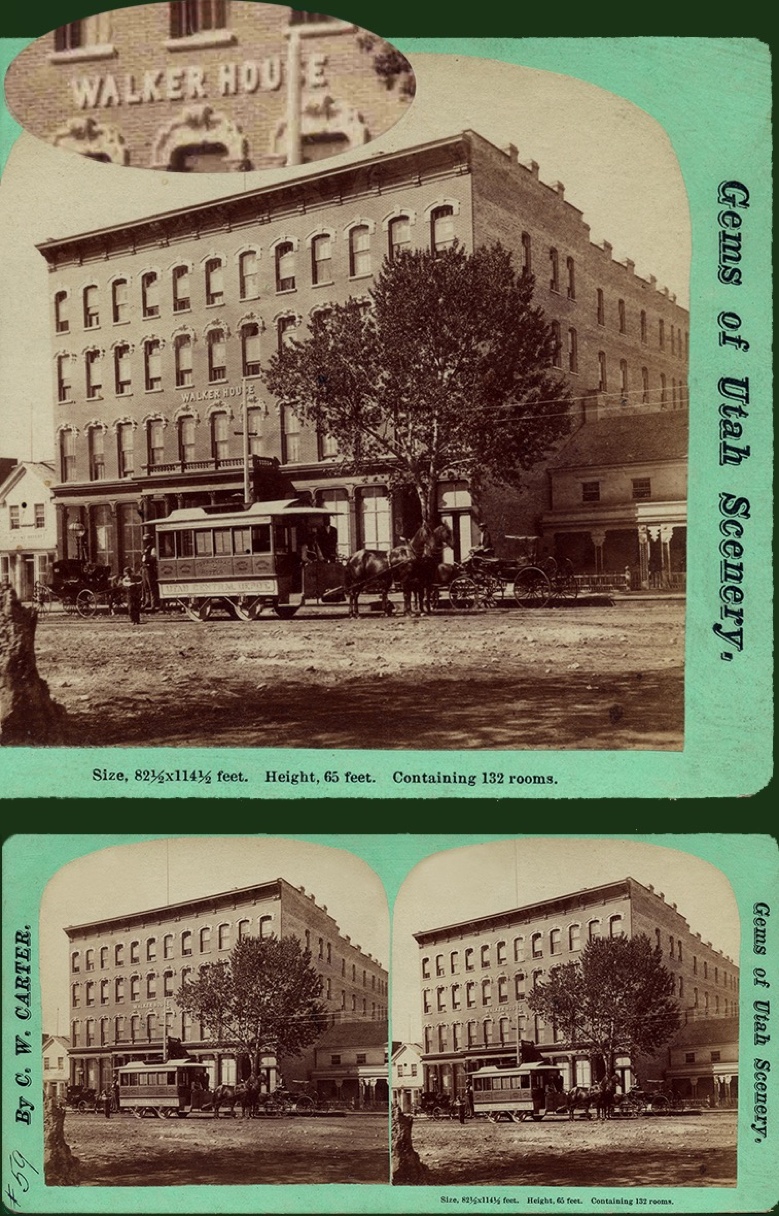



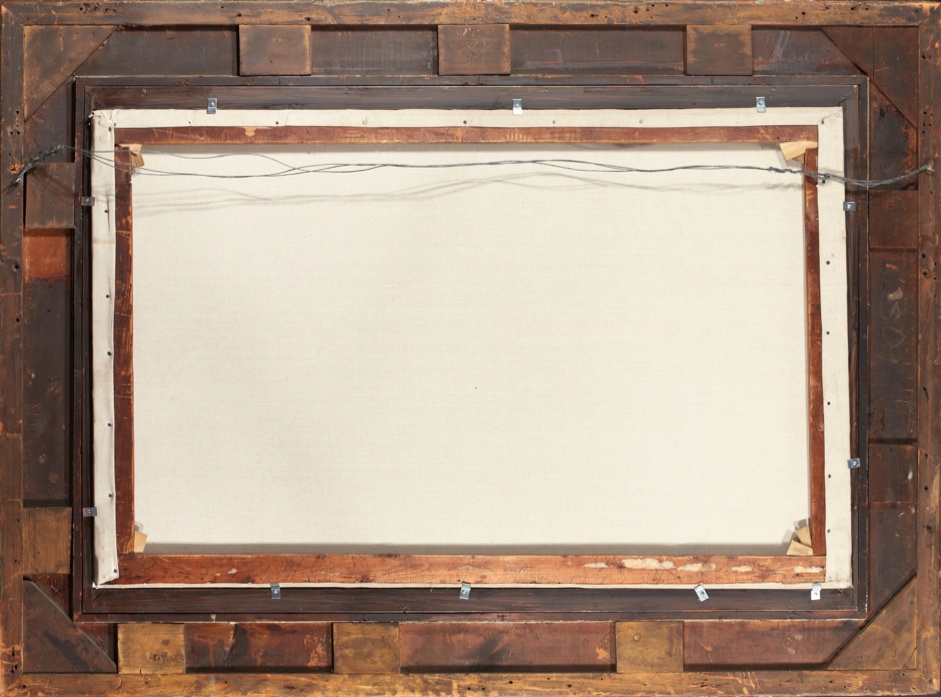




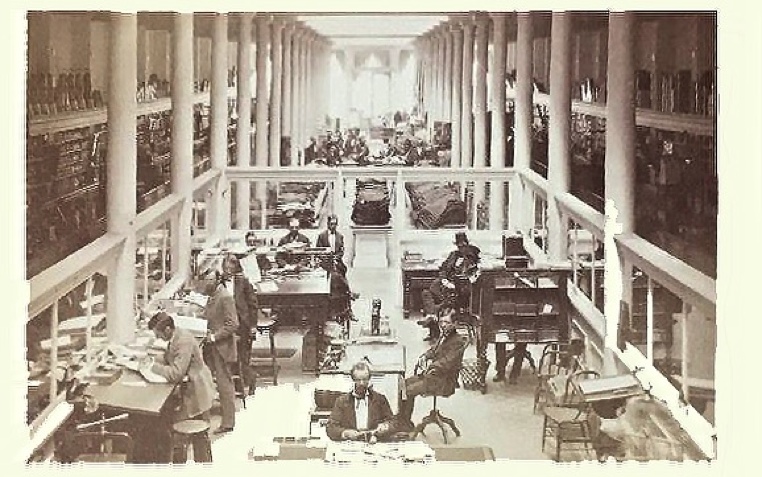





Salt Lake City - Salt Lake Valley circa 1860 looking north-west towards the Oquirrh Mountains
(Courtesy: Private Collection)
Salt Lake City circa 1880's looking north-west towards the Oquirrh Mountains
(Courtesy: Richard Warren Lipack Collection)
**************************************************
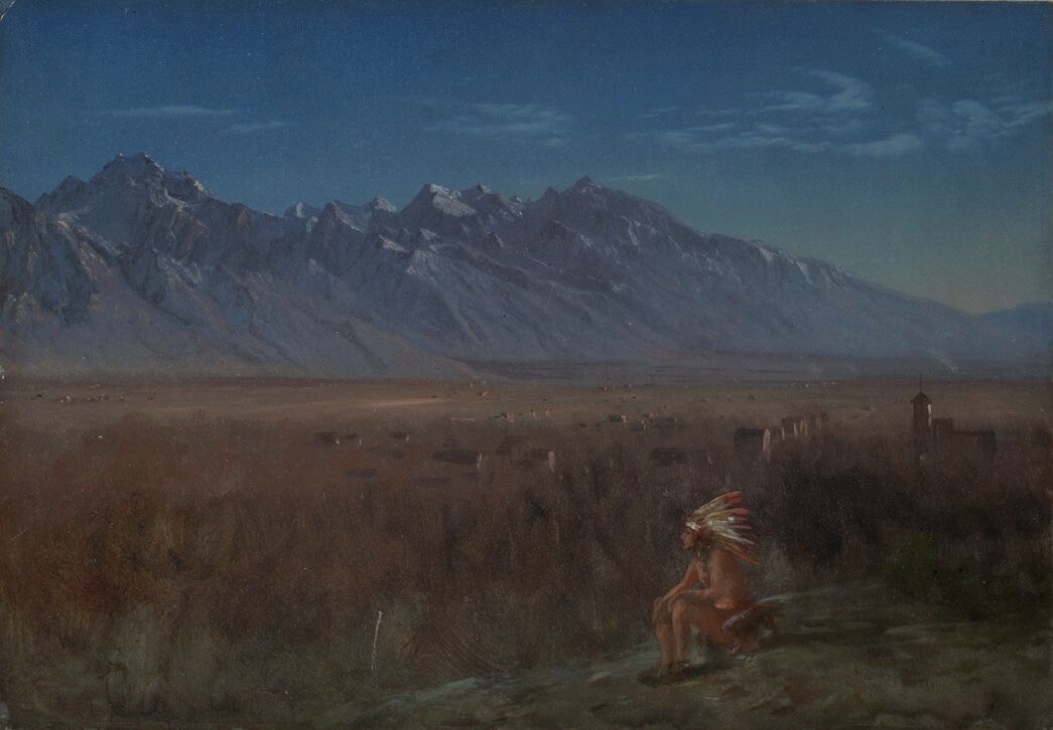
"MORMONKEY: The Key to News and History of the Mormon Faith"


